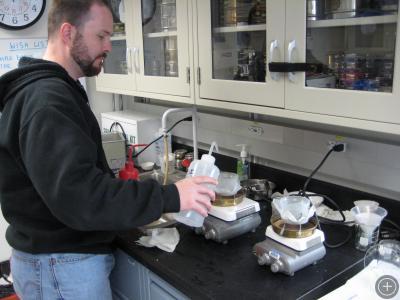On Seasickness & Science, Part 1
ABOARD THE JOIDES RESOLUTION, ON THE BERING SEA– So the last few days have been a whirlwind of activity. We arrived at site UMK-4D and dropped a beacon while deploying thrusters to maintain dynamic positioning. The beacon is one of the redundant ways we make sure we stay put during the drilling process. UMK-4D was the site name from the original proposal for this cruise. I learned that the designation of each site changes once drilling starts. The scientists and technicians were all excited to get started. We were told that core would be on deck late that night. Lots of folks stayed up to welcome the core. I decided it was a good idea to sleep some after my shift and wake up when core was near. I got up late in the evening, or early in the morning, and made my way up to the core deck. Still no core, so I slinked back down to my stateroom for some more sleep.
A few hours later I made my way back up again. Still no core, but the technicians were having a dance party. I decided I had suffered enough, and went back to bed. This time was for good. The core could wait for me now. It was already close to 3am if not after. And I have to wake up around 5am to be ready for my 6am shift anyway. So I got up at 5am, got ready, and made my way up to the core deck again arriving just before 6am. And the first core had arrived at 5am. Oh well. It turned out that more would soon arrive.

These hot plates with magnetic stirrers separate sediment from dinoflagellate (a kind of marine plankton) remains.
So drilling was in full swing at the newly named site U1339 in hole “A”. Everything was going well for the first four cores. I suppose a bit of terminology is in order. You see, each hole takes hours to drill. Every 30 minutes or so core will arrive on deck. This core is one long tube of mud, which is then cut into 7 sections (approximately 1.5 meters in length) by the technicians and those are accompanied by the core catcher, which is the mud caught in the device which pulls up the core at the bottom, but it can be highly disturbed. They advance the drill 9.5 meters each time, but the recovery is often greater than that due to expansion of the core after the pressure change of coming from the bottom of the ocean to the surface. For this expedition the plan is to drill to around 200 meters in most of the holes. There are some which are shallower and two which will go to 700 meters. In any case U1339A was supposed to be 200 meters, but something went wrong with the drill assembly, so the entire process was stopped at 4 cores. We moved on to the next hole, and the decision was made to use the first 4 cores from U1339B to meet the needs of the microbiologists on board, and then supplement the first part of U1339A with the rest of U1339B. From that point on things went smoothly for the rest of the site at holes U1339C and D.
The weather was great, the seas were calm. We had some time to catch glimpses of the school of Dall’s porpoises that constantly patrolled around the boat. Occasionally a seal would swim by.
When the last hole was finished the logging began. It was the evening of the 4th day on site. The logging process involves dropping many different tools into the hole and slowly pulling them up, making measurements as they go. This entire job takes about 12 hours so they finished up early in the morning. By the time I woke up the next morning the drill pipe was almost on board. The seas were picking up strength and the wind was around 20 knots and climbing. The beacon was released when we sent the radio signal to it, and it was fished out of the water. We pulled up thrusters and off we went. Only this time with a little more motion than the last.

 No comments
No comments 





